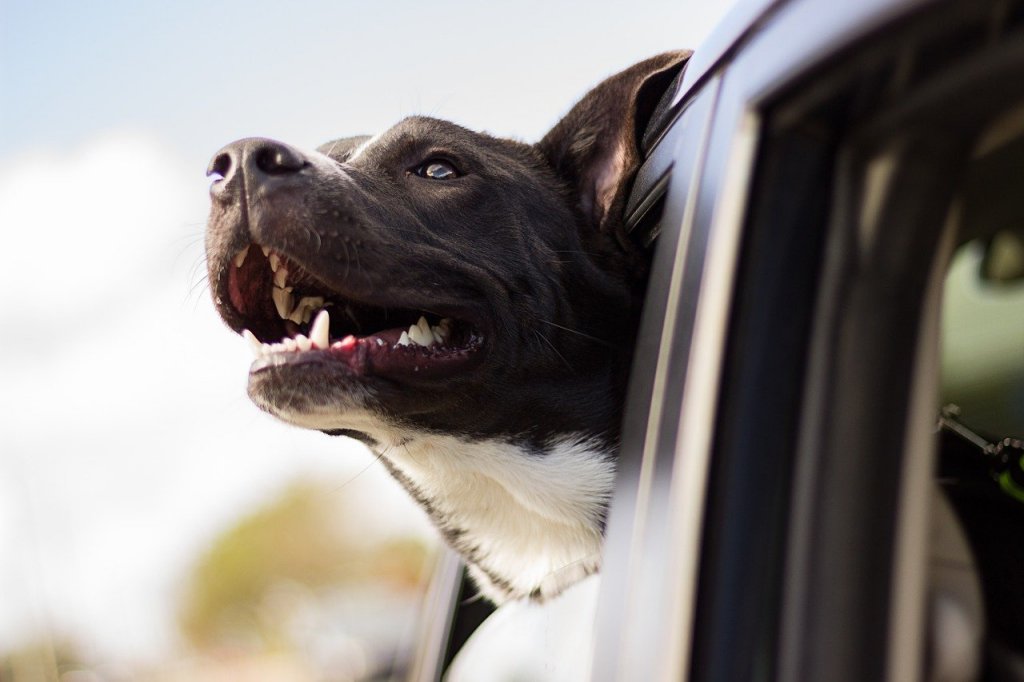
The simple advice to combat high gas prices is often to drive a more fuel-efficient car such as a hybrid or even an electric car like a Tesla. But that’s not always possible and it’s easier said than done. Sometimes we’ve got to make do with what we got, which means modifying our behaviors and finding ways to save money on gas.
One of the interesting things about keeping mileage and gas logs for business-related driving is being able to look back through the years to see how gas prices have changed.
When I bought my last car in 2004 and started keeping track, I paid $1.74 a gallon for regular here in Georgia for a fill-up. Prices hit a high of $3.99 a gallon in 2008 and I was wondering if we’d see sub $2 gas ever again as I watched money disappear from my bank account into my gas tank. Turns out gas didn’t keep going up and prices dropped back down to $1.83 in January 2019.
As someone who has owned SUVs for the past 15 years and got less than great gas mileage, I’ve learned a few ways to save money on gas and how to be more efficient with my driving.
Here are my tips and strategies on how to save money on gas besides buying another car.
Table of Contents
Saving Money on Gas Starts At The Gas Station
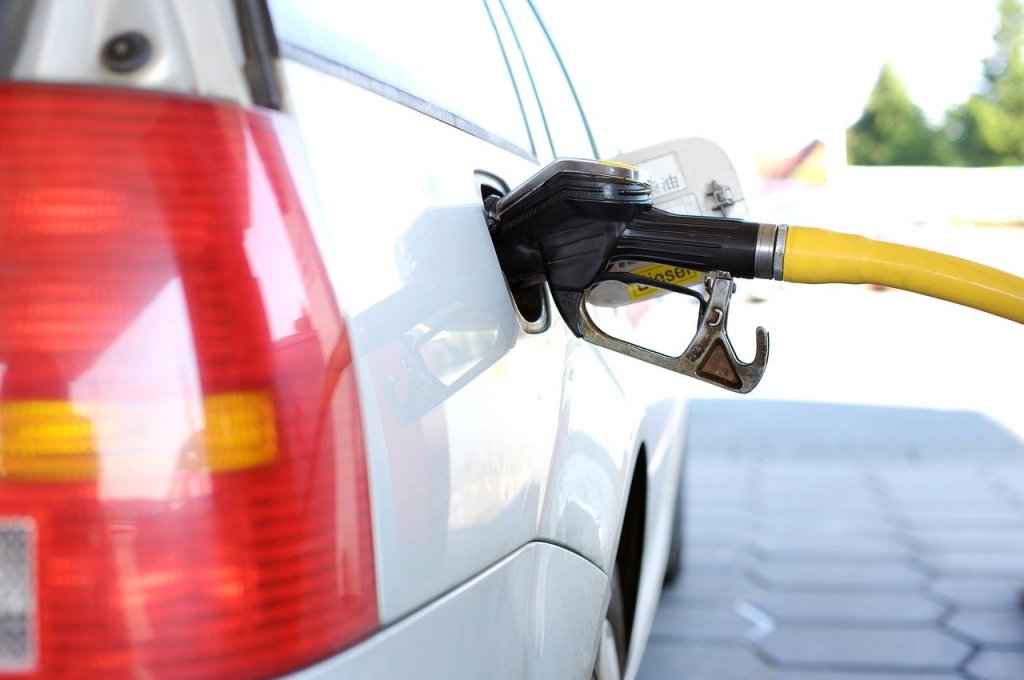
Use A Gas Rebate App
Save money every time you stop at the pump. I have been paying 12 to 25 cents less per gallon than the price listed on the sign at local gas stations with the GetUpside app. The app has been growing extremely fast with over 26,000 partnership gas stations and convenience stores with more added every month.
After installing the app and creating an account, saving money is as simple as opening the app when you need gas and seeing which nearby stations are offering the biggest cash rebates and the lowest prices. After accepting the offer, make your way there and fill up as you normally do with a credit or debit card. Afterward, take a picture of the receipt and in a few days, money appears in your GetUpside account. You can then cash out to your bank account, Paypal, check, or as gift cards.
Download the GetUpside app and use the promo code AFF25 to get an additional 25 cents off your first fill-up as a new member.
Read my full review of the GetUpside app.
Find the Lowest Prices Using Comparison Sites
Use the GasBuddy app or website and other similar tools to compare fuel prices in your area. These sites and apps display prices crowdsourced by a legion of users to help you save time and money. You can use your phone’s GPS to show prices in your current location or you can search for prices by zip code or city. No longer do you have to wonder if you are getting the best deal nor do you have to drive out of your way for mediocre or non-existent savings.
Join a Warehouse Club
Warehouse clubs such as BJs Wholesale, Costco, and Sam’s Club sell gasoline that almost always beats nearby competitors’ prices. Warehouse clubs like Costco makes the bulk of their profits from membership fees. Gasoline is used as a draw to get people to sign up for memberships and stop into the warehouse for rotisserie chicken, giant boxes of cereal, and other products after gassing up their cars.
I’ve seen gas prices at my local Costco from anywhere between 3 cents to more than 20 cents less than other the gas stations in the area. If you drive a lot, your gas savings may even cover the cost of the warehouse membership, making access to the warehouse a bonus.
Use my Costco Gas Calculator to quickly see how much gas you would have to buy to start coming out ahead on a membership.
Sign Up for the Gas Station Rewards Programs
You have a combustion engine car that needs gas to run. If you are going to be at the gas station weekly, biweekly, or monthly anyways so why not take a few minutes and sign up for your regular gas station’s rewards program and save some money while you are there.
Every major gas station chain has a program to reward loyal customers. Exxon has Exxon Mobil Rewards+. Shell has their Shell Fuel Rewards. Speedway calls theirs Speedy Rewards. QuikTrip’s is QT Rewards. BP stations offers the BP Driver Rewards and so on.
Through these programs, you can get discounted gas, earn points for gas and convenience store purchases that could be redeemed for airline miles, or get free stuff. Even grocery chains like Kroger have a fuel program tied into their shoppers’ card to earn discounts at their fuel centers or Shell gas stations.
Get A Rewards Credit Card
Some gas stations’ rewards programs are tied into a credit card so you can kill two birds with one stone.
Another option is to get a traditional credit card that offers airline miles, membership points, or cashback. Some cards like the Bank of America Cash Rewards credit card lets you earn 3% bonus cashback on a category of your choice, which can include gas purchases. If you are a Costco member, their Costco Anywhere Visa card has 4% cashback on gas.
If you do get a credit card for gas, be sure to pay off the entire balance every month so you do not owe any interest.
Stop Buying Premium Gas
Check your owner’s manual, or look on the fuel cap or fuel door to see if there is a notice saying that premium fuel is required. If your car requires premium fuel, then you must use it to prevent engine damage.
If you see that premium fuel is “recommended”, it means your car will get the best performance or mileage if premium gas is used. You should track your mileage using different grades of gas and see if premium is worth the cost.
Cars that only need regular gas will not benefit from using premium gas. Premium fuel in my area is 50 cents more than regular and there is no point in filling up with premium when only regular is needed. You are literally burning money out of your tailpipe if you use a higher octane gas than recommended by the manufacturer.
Some drivers feel that higher grades of gas have more additives and detergents and it is better for their engine. What you should do instead is buy gas from stations that meet the Top Tier Gas standards. All gas comes from the same place and the different brands add their own additive pack before trucking it to their gas stations. Gas from Top Tier licensed stations has been tested to meet or exceed the minimum amount of additives and detergents recommended by car manufacturers.
Fuel-Efficient Driving Tips
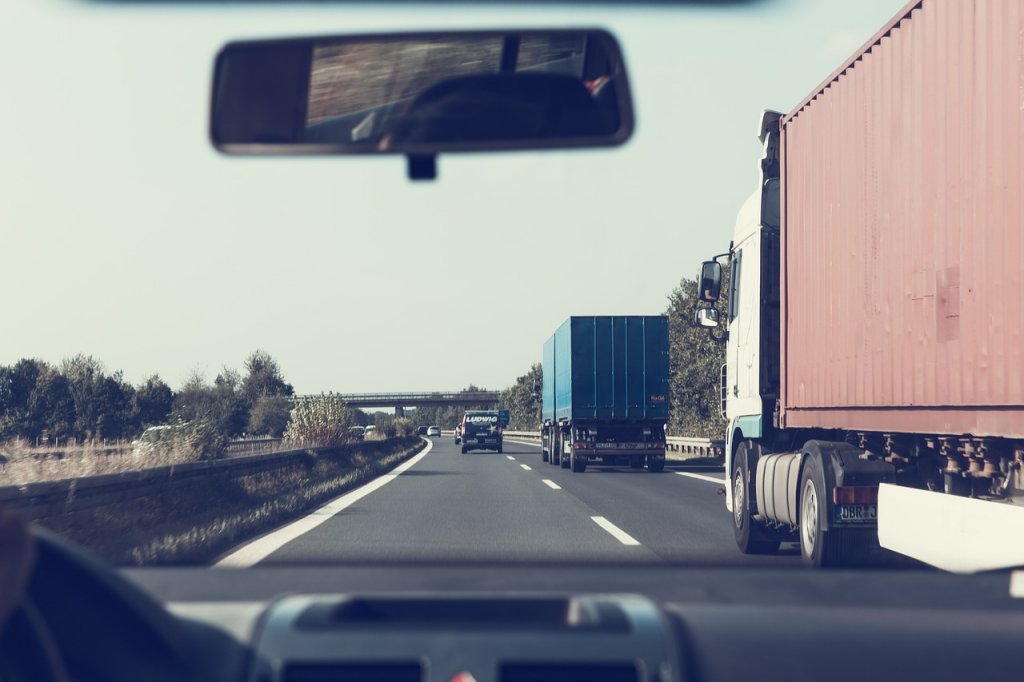
Stop Warming Up Your Car
Modern cars with fuel-injected engines do not need to be warmed up a long time before driving. This includes in the wintertime when it is below freezing. The idea of starting up the car and letting it warm up comes from when cars were carbureted.
Read more: Why Warming Up Your Car Does More Harm Than Good
Personally, I prefer to start up the car, wait about 30 seconds to a minute for the RPMs to drop, and then drive away slowly.
Letting your car idle in the garage or driveway does nothing but only warms up the engine, wastes gas, and creates pollution. Cars get the worst gas mileage when idling; you are burning gas but going nowhere. Your tires, transmission, and other parts of the car will still be cold. Your car as a whole will warm up faster if you put the engine under load.
Minimize Idling
Many newer cars already have stop-start technology that turns off the engine when stopped to reduce idling and pollution. When you are stopped and are waiting for your spouse to run into the store, waiting at a railroad crossing for a train to pass, or stuck in a traffic jam, turn off the engine.
Also instead of using drive-thrus at the pharmacy, fast food restaurants, or at the bank, consider parking your car and walking inside. Not only are you saving gas, but you are also getting some extra exercise.
Slow Down
Going fast might be exciting, and there might also be a bit of peer pressure from trying to keep up with cars around you, but driving fast is horrible for your gas mileage. The faster you drive, the higher the wind resistance and the more drag it creates.
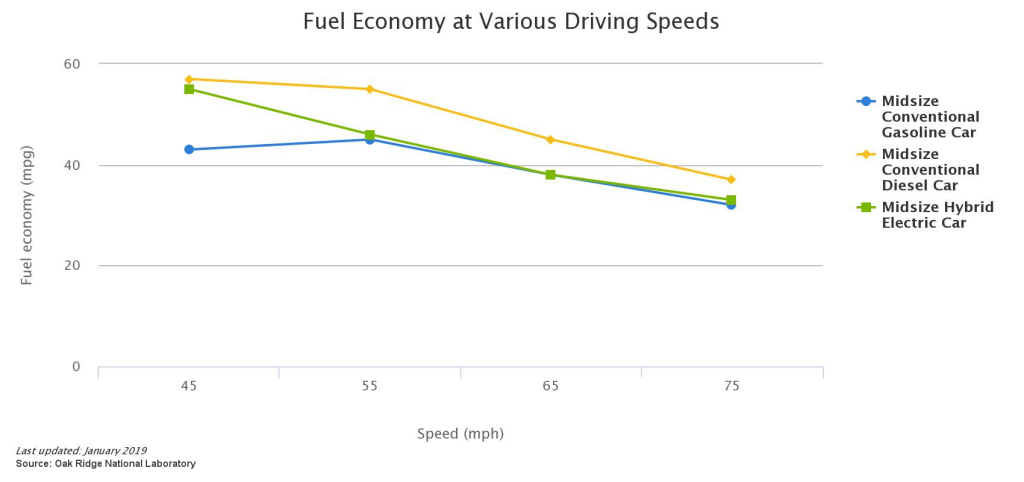
As seen from the above chart, fuel economy starts dropping fast when conventional gas and diesel cars go past 55 mph.
Not only does driving slower help you save money on gas, but it is also safer. Slower speeds give you more time to react to something on road. It also saves you money from speeding tickets.
I also find that I arrive at my destination more relaxed if I budgeted more time and wasn’t in a rush.
Accelerate Gradually
My last car had an instant fuel mileage display that showed the current MPG. When accelerating from a stop I would get the worst gas mileage, at less than half my average gas economy.
Think about it. You need a lot of engine power to get a two-ton metal box moving from a complete stop. The faster you want to get going, the more gas the engine needs. You get the best fuel economy once you get to cruising speed at the highest gear.
Stop racing from light to light. If your state’s Department of Transportation is any good at their job, they would have set the traffic light timings to minimize stopping and starting to keep the flow of traffic moving.
Almost every time I’m first at a stoplight, cars next to me will take off as quickly as possible while I take my time. 90% of the time, we end up at the next light together, only I got there using less gas and I sometimes get there right when the light changes to green.
Keep A Safe Following Distance
Leave a bit more distance between you and the car in front of you. You might have seen the Mythbusters episode about drafting big rigs to save gas, and while that is true, it is still recommended to keep a 3 or more second following distance. When you are farther back, you will be able to see further ahead and give you more time to plan ahead for braking.
Aggressive driving such as speeding, rapid acceleration, and hard or frequent braking wastes gas.
Other benefits of not following so closely is avoiding rear-ending someone due to sudden stops, being able to see road hazards, and preventing chipped or cracked windshields from debris thrown up by the car in front of you.
Plan Ahead When Braking
You see the light change far up ahead to red. Rather than keep speeding toward it to get to the light faster, let off the gas earlier and let the car coast. Not only does doing this save gas, you also extend the life of your brake pads.
The only benefit to getting to the light faster is being rewarded with sitting there waiting for the light to turn green while watching the person in the car next to you pick their nose. Time it right and you might even get to roll through right when the light changes.
Reduce Extra Drag and Weight
Place items inside your car or trunk rather than outside on roof racks. An even better option is to leave them at home. If you don’t need to use that ski box, rooftop tent, cargo rack, ski rack, kayak, or bike rack, take it off the car. Research has found that items on the roof could increase your gasoline bill by 25%.
If you have a SUV, consider getting a bike rack or cargo basket that mounts into the receiver hitch behind the car rather than on top to increase your aerodynamics.
This brings up the next point. Remove any heavy items and extra weight you are carrying around in your car. It is estimated that an extra 100 pounds of weight in your vehicle can reduce your fuel economy by 1%. Take a few minutes and remove your golf bags or your kids’ baseball equipment from the trunk if it isn’t going to be needed that day.
Use Cruise Control
I can usually do better controlling the accelerator myself, but for some people, using cruise control on the highway and on long trips can be a big help with keeping a constant speed and prevent inadvertently going faster and faster with other traffic.
Balance Comfort and Fuel Efficiency
Using extra accessories means using more power, which at the end of things, comes from burning gasoline. This could mean using heated seats, the heater, and window defrosters in the winter and running the air conditioning and fans in the summer.
Rolling down the windows also has a negative effect on gas consumption due to the increased drag, but it is not as bad as running the A/C. The faster you drive with the windows down, the more drag increases. Some experts believe the breakeven point of using the A/C or driving with the windows down is somewhere between 45 mph and 75 mph depending on the car and a variety of variables. However, I prefer leaving the windows up at higher speeds because the extra wind noise is bad for your hearing.
In the summer, rather than set your A/C to max after getting into your car, roll down the windows when you get up to speed to blow out all the hot air from your car quickly. That way your A/C doesn’t have to work as hard to cool down the car.
Stop Cruising For Parking
You see it all the time at the store. Some people will drive in circles around the lot trying to get that closest spot to the entrance so they don’t have to walk as far. All the while they are wasting gas in their car. Meanwhile, there are a bunch of empty spots a bit further out. By the time they snag that perfect spot, someone who parked further away would have already made it into the store.
I could see parking closer would be beneficial when it is raining, but on a perfect sunny day, the extra exercise will be good for you. Plus, when you are parked away from other cars you are less likely to end up with door dings.
Car Maintenance Tips For Better Fuel Economy
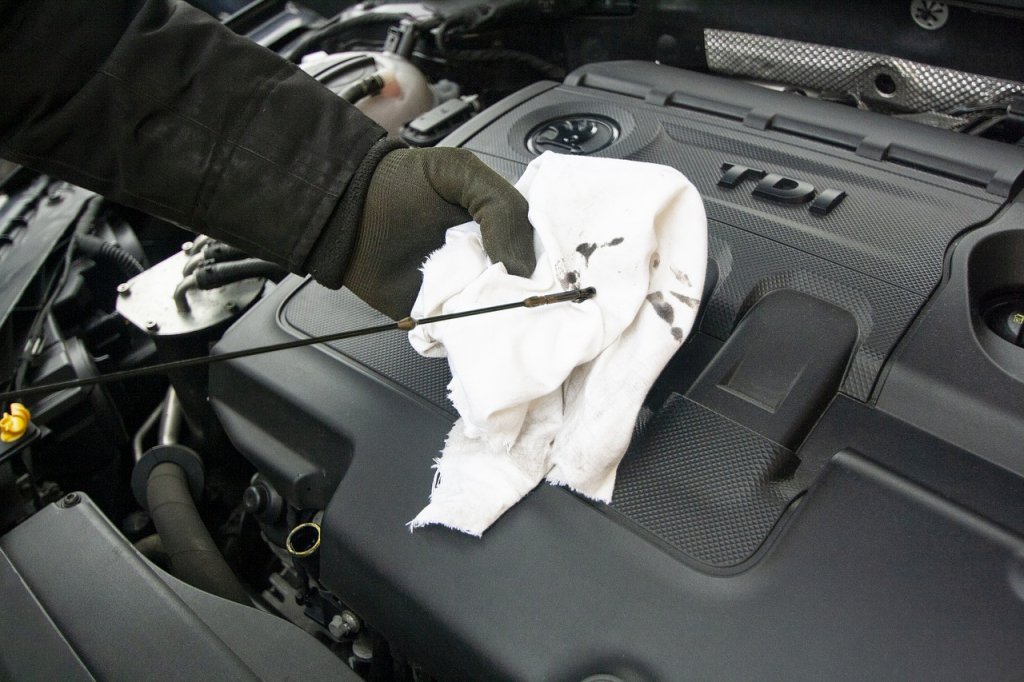
Check Your Tire Pressure
Not only is driving with low tire pressure dangerous, but it also reduces your gas mileage because of higher rolling resistance. Low tire pressure also leads to your tires wearing out faster, giving your wallet a double kick to the butt.
Many cars these days have a tire pressure monitoring system (TPMS) that alerts you when your tire pressure is too low. When the light comes on, your tire is already 20-25% below the tire pressure recommended by the manufacturer on the sticker at the driver’s door jamb or glove box.
Check your tire pressure regularly with a cheap tire pressure gauge. You should check the pressure when your tires are cold. When the weather gets colder, the tire pressure will also drop so always check in the fall after that first cold night before winter comes.
See this list for places where you can get free air for your tires and keep your tires inflated to get the best gas mileage.
Change Your Engine Air Filter
Over time, the air filter for your engine gets clogged by dust, pollen, dirt, and other contaminants from the air. This prevents your engine from getting enough air and decreasing its performance. This leads to increased fuel consumption when you try to get up to speed and need to stomp on the accelerator to do it.
The interval for changing your filter depends on your driving. Most mechanics say to change them between 15,000 to 30,000 miles. If you drive on a lot of dirt roads, you would have to replace them on the shorter end of the scale.
Changing an air filter is easy enough that almost anyone can do it at home. You go buy the correct filter for your car, remove a few screws, and swap out the old one for the new one.
Keep Your Car Clean
An episode of Mythbusters found that a clean car got 2 mpg or about 10% better fuel economy over the same car caked in mud. A dirty car covered in mud and bugs increases the drag coefficient. The exact amount of reduced fuel efficiency will depend on the amount of dirt, size, and location.
Keeping your car clean and smooth will help with your aerodynamics. Plus, a car covered in mud means it will be carrying around a lot of extra useless weight.
Money-Saving Commuting and Planning Tips
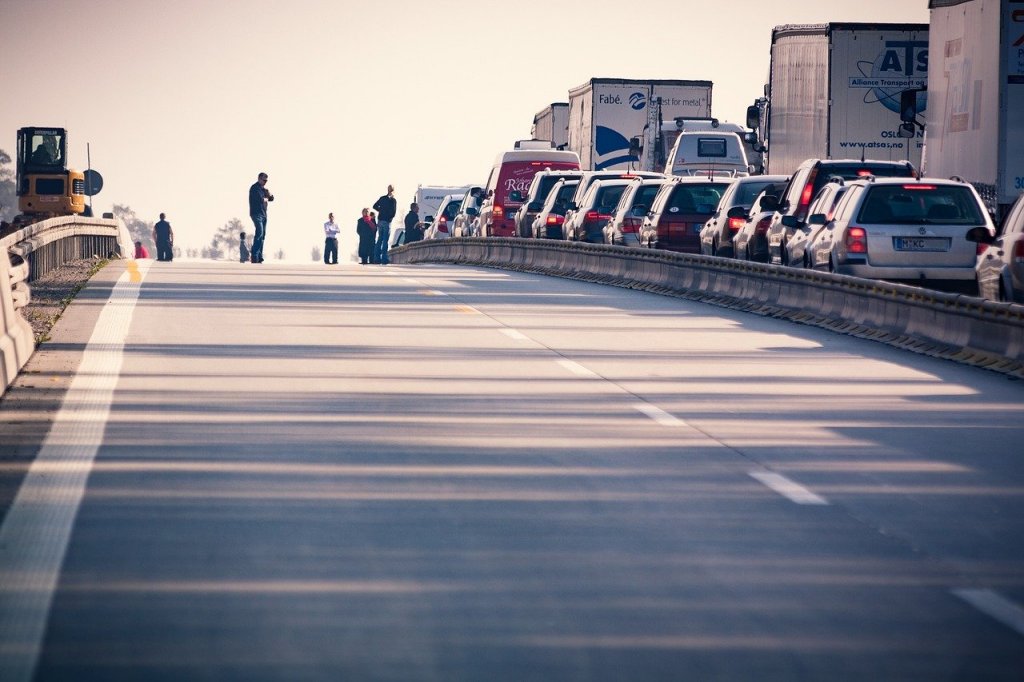
Combine Trips
I know the last thing you would want to do after work is to stop at the store for groceries or running other errands. However, combining multiple stops in one big trip when your engine is already warm gives better fuel economy than making several short trips with a cold engine.
Avoid Peak Rush Hour
If you have a flexible work schedule, try to avoid peak rush hour when everyone else is on the road trying to get to work or back home. Either leave for work earlier or later in the morning and do the same in the evening.
Optimize Your Routes
Look to see if there are more efficient ways to get to places where you go regularly. The interstate might be the most straightforward way to get to your work in the morning, but if your freeways turn into a parking lot during rush hour like here in Atlanta, a different route such as taking side streets might be quicker with less stop and go traffic.
Using a navigation app like Google Maps or Waze that re-routes for traffic might get you to where you are going faster and more efficiently.
Looking on the map and finding a shorter way that cuts your commute by a mile will add up over the course of a year if you are driving it daily. When possible, try to take the route with the least number of stop signs and stoplights to reduce stopping and starting.
Try Telecommuting
Convince your boss to let you work from home a few days of the week by explaining that you can use the extra hours saved from commuting to get more work done. You save money on gas, reduce wear and tear on your car, and your workplace gets higher productivity. That’s a win for everyone.
Read more: Why Your Commute is Ruining Your Life and Your Health
Pay Attention To Where You Park
In the summer, park your car in the shade to lower the cabin temperature so you won’t need to turn on the air conditioning as high to cool down your car.
In the wintertime, park your car inside your garage so the engine and fluids don’t get as cold, reducing the amount of time for the engine to reach operating temperature.
Carpool or Ride-share
Taking turns driving with friends or coworkers will reduce the wear on your car along with saving on fuel costs. Even if you do all the driving, having someone chip in money for gas still helps keep more money in your wallet.
Having other passengers in the car will also let you use the HOV lanes. These lanes are usually less congested, meaning less time spent sitting in traffic wasting gas.
Take Public Transit
If public transportation is available and convenient for you, taking the bus or subway lets you leave the car at home and have someone else do the driving. This means you can spend time on the commute to get work done, read this blog for more ideas on how to save money or catch up on sleep.
Closing $ense
Follow these simple gas-saving tips and you’ll be spending less time at the pump, which means more money in your bank account. No matter whether you are driving an economical compact car or a gas guzzler, these tips will work for everyone. In fact, some of these techniques will even work for people who drive electric cars. Who wouldn’t like getting more range between fill-ups or less time spent at the charger?
What are some other ways you can suggest to save money on gas?

Thanks for your great tips on saving gas!
I can’t agree more with your tip on “Plan Ahead When Braking”. My hubby and I love to drive this way for the reasons you give. Not driving fast and furious is safer and also reduces engine, suspension and tire wear 🙂
Thanks for the feedback, Jo Anna!
You are right. It’s all about driving smoothly. Accelerate away from lights smoothly and slow down gradually and you’ll save on gas and your car will last longer. It’s that easy. Plus, your passengers will thank you for not making them car sick.